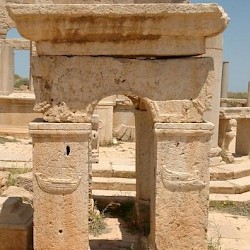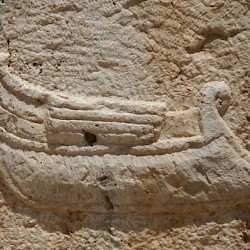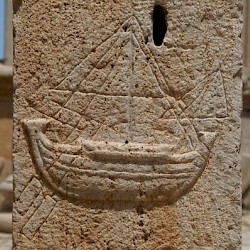Lepcis Magna, Macellum
Lepcis Magna: Phoenician colony, later part of the Carthaginian empire, the kingdom of Massinissa, and the Roman empire. Its most famous son was the emperor Septimius Severus (r.193-211).
Macellum
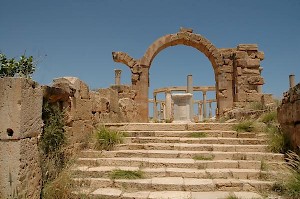
The first Lepcitanians will have used the Old Forum as their market place, but it turned out to be too small when the city started to grow during the reign of the Roman emperor Augustus (27 BCE - 14 CE). As a consequence, a second market was built along the Cardo. The process is not unique: in Rome itself, the Fora of Caesar and Augustus were built.
The new market, built in 9-8 BCE, consisted of a large square, surrounded by a portico, in which two octagonal buildings were placed, which are known to archaeologists as tholoi. In the shade, people could sell and buy food. There's a similar building in Timgad.
 Map of the macellum in Lepcis Magna |
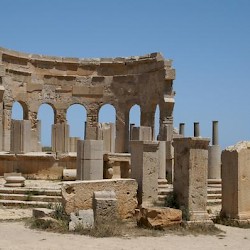 Lepcis Magna, Macellum, northern tholos |
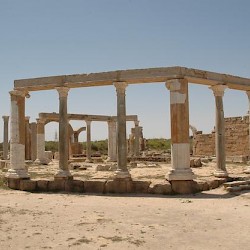 Lepcis Magna, Macellum, southern tholos |
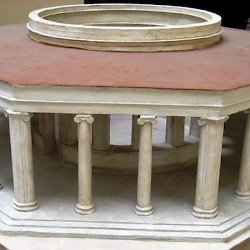 Lepcis Magna, Macellum, model of a tholos |

According to the inscription known as IRT 319, the money to build a new market was paid by a man named Annobal Tapapius Rufus, a member of the Tapapius family that dominated Lepcitanian politics in the early days of the Roman Empire. The inscription is interesting, because it is one of the first written in Latin (only IRT 481 may be older).
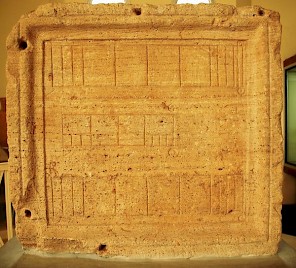
The macellum was carefully maintained, but changes were made. For example, the original entrance of the macellum was in the southwest corner, which is a bit strange, because the city itself was in the east. A new entrance, in the south, was added in the Severan age, when the tholoi were rebuilt out of marble.
In the porticoes surrounding the two tholoi were tables. The table on the photo to the right, now in the Museum of Lepcis Magna, was used for measures: you can see the Punic cubit of 51.5 cm, the Roman foot of 29.6 cm, the Ptolemaic cubit of 52.5 cm, and their subdivisions. On another table, an inscription was added to commemorate the two market masters (aediles) who had paid from their own money for tables they had ordered to be made.
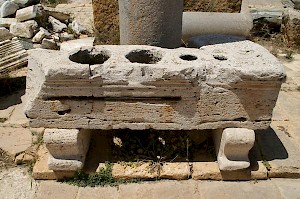
Any public building was full of monuments for special citizens. Above is a miniature honorific arch that may originally have been used to honor a wealthy shipowner, because it is decorated with very fine reliefs of two ships. The first of these is clearly a freighter with sails that may as well have been rowed, if the structure on its side is an oarbox. This is the type of ship mentioned in the Fourth Letter of Synesius of Cyrene. The second one is also a cargo ship, although this time it is a galley, and has no sails.
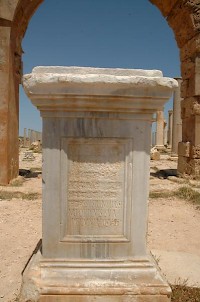
Later, the miniature arch was reused as the pedestal of a two-horse chariot for a man named Porfyrius, who is mentioned in the inscription as the benefactor who had donated he donated "to his fellow citizens four living beasts with teeth".note These beasts with teeth (feras dentatas) are almost certainly elephants, which were indeed quite a spectacle, because the original North-African elephants (loxodonta africana pharaohensis) had become extinct. The animals killed in the amphitheater must have been the big African bush elephants (loxodonta africana), brought across the Sahara.
Inscription IRT 628, placed in the Severan entrance, is barely legible because a great deal of the text has been erased in what appears to have been a damnatio memoriae. What is obvious, however, is that the monument was dedicated to a man named Quintus, and that the monument was erected by his mother, Aemilia Victrix, whose name is still legible in lines four and five. The remaining text, which was not erased, tells that she paid for it from her own money, and had received permission of the town council (Usually, damnatio memoriae was an emperor's risque du métier. It is uncommon, but not unheard, of that the memory to a private citizens was cursed.)
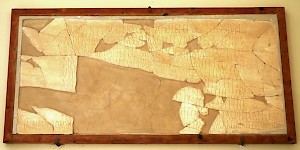
Inscription IRT 468 is now in the Museum of Lepcis Magna. It mentions repairs to the ruined macellum, by Constantine I the Great and his colleague Licinius. It is the youngest inscription from this building, which was certainly abandoned by the fifth century. When Belisarius captured the city in 533, the new wall was close to the Old Forum; the western part of the city remained covered with sand.note
